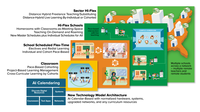Five hundred years ago, Nicolaus Copernicus posited a heliocentric model that stated the Earth evolved around the sun. He published his handwritten manuscript in 1543, setting off what some historians would call the Copernican Revolution. Throughout history, humankind has introduced new innovations that challenge the established orthodoxy of the time. Another example involves the Catholic Church banning the Gutenberg printing press. In these cases, one reality is clear—innovation will win out. Another reality of innovation is that more jobs will be created than displaced.
This was certainly the case with the internal combustible engine (ICE). ICE can, in part, be attributed to Nicolaus Otto’s 1864 development of the “atmospheric gas engine" and its further refinement twelve years later. Henry Ford’s refinement in the early 20th century leveraging production line assembly innovation resulted in the successful launch of the Model T, thus ushering in the modern-day transformation of ICE, the creation of scores of jobs, and the creation of new businesses. Could modern-day AI be our Model T moment?
A yes answer to this question may elevate humankind to higher levels of life, liberty, and the pursuit of happiness, conferring wealth, power, and prestige to those who harness its capabilities. As practical optimists, we believe as a society, we have an opportunity to transform our communities, ushering in a new level of opportunity for all of us.
From the technology side, we are excited about AI and its capabilities. AI will transform many businesses, just as ATMs have revolutionized banking, rideshare apps have changed transportation, and smartphones have transformed the human-computer interface.
AI and the business of business
Before addressing the impact of AI and automation on the US labor force, let’s look at a brief overview of four domains (RPA’s, Insights, Engagement, and Creation) in which AI can play a major role in augmenting the human dimension of work.
RPA
Aaron Bultman defines Robotic Processing Automation (RPA) as “a form of business process automation that allows anyone to define a set of instructions for a robot or ‘bot’ capable of mimicking most human-computer interactions to carry out a ton of error-free tasks at high volume and speed.” One example could be deploying an AI-enabled RPA with an ERP and LMS currently used by most colleges. AI can enhance the intelligence of these systems by searching for patterns within the data and linking them to our learning management systems to harness its predictive power of data. This would enhance our ability to personalize a learning plan for every student based on their individualized needs.
Insights
Predictive Analytics: Using AI to analyze historical data for trends and patterns to forecast future events, behaviors, and outcomes.
Sentiment Analysis: Understanding customer sentiments and market trends through social media and review analysis.
Real-Time Data Processing: Utilizing AI for immediate analysis of streaming data from IoT devices, online transactions, etc.
Engagement
Personalized Customer Experience: AI-driven customization of user experiences on websites, apps, or marketing campaigns.
Chatbots and Virtual Assistants: Implementing conversational AI for customer service, support, and interaction.
Emotion Recognition: Using AI to interpret customer emotions in real-time through voice or facial recognition to enhance service quality.
Creation
Content Generation: AI algorithms creating written content, artwork, music, or video content.
Product Design and Development: AI-driven tools aiding in the design of new products by predicting trends and customer preferences.
Automated Software Development: AI algorithms assisting in code generation, testing, and debugging software.
In each of the following domains, AI adds a layer of intelligence and adaptability, enabling more sophisticated, efficient, and personalized solutions. These applications not only streamline operations but also open new avenues for innovation and customer engagement. AI is poised to take these changes even further:
In healthcare, AI's predictive analytics and diagnostic tools promise to revolutionize patient care and treatment methodologies. The hospitals that integrate patient experience with all the other healthcare data pertinent to that patient and make recommendations for the most affordable solution for the customer through the power of AI will probably become ‘the next big thing’ in healthcare.
In finance, AI's data processing and analysis capabilities transform everything from personal banking to investment strategies. However – the financial institutions that redesign their customer interactions based on AI will be able to propel forward into the post-AI world.
In education, AI will personalize learning experiences, adapt content to individual learning styles, and even allow students to find relevant learning content and resources seamlessly through the power of student data integration.
Upskilling for the Future
With AI reshaping job landscapes, it's crucial for professionals to consider upskilling. Whereas before, such rapid changes in jobs were primarily restricted to technical fields; AI will bring a rapid rate of change to many more industry verticals. Make sure you are ready. Embracing AI literacy, understanding data analytics, and developing a mindset for continuous learning is key. Acquiring skills complementing AI technologies will be essential for thriving in the new AI-powered era.
Remember, the field of AI is vast and constantly evolving, so continuous learning and experimentation are key. Tailoring your learning path to your interests and career goals can also make the journey more engaging and fruitful.
The research and data from The World Economic Forum serve as a useful guide to the impact of AI and automation on the future of work. In their latest report, “The Future of Jobs 2023,” a top-line finding is that at least a quarter of all jobs are expected to change significantly due to AI and automation in the next five years. This includes changes in skill requirements, tasks performed, and even work locations. The report projects that:
● 44% of workers will need to be reskilled or upskilled over the next five years to adapt to these changes and remain employable.
● Some jobs are at higher risk of displacement than others. Jobs with routine tasks, predictable environments, and limited creativity are more susceptible to automation.
The McKinsey Global Institute recently published their report “Generative AI and the future of work in America, July 26, 2023”, offering the following:
● By 2030, activities that account for up to 30 percent of hours currently worked across the US economy could be automated—a trend accelerated by generative AI. However, we see generative AI enhancing the way STEM, creative, and business and legal professionals work rather than eliminating a significant number of jobs outright. Automation’s biggest effects are likely to hit other job categories. Office support, customer service, and food service employment could continue to decline.
● The United States will need workforce development on a far larger scale as well as more expansive hiring approaches from employers. Employers will need to hire for skills and competencies rather than credentials, recruit from overlooked populations (such as rural workers and people with disabilities), and deliver training that keeps pace with their evolving needs.
Workers will need to be exposed to continuous re-skilling and upskilling opportunities either through their employers, educational institutions, or a combination of the two. Colleges and Universities would be well advised to align their offerings to the changing demands of the labor force to ensure a steady pipeline of enrollees. Work-based opportunities integrated into existing educational and training programs may prove to be important to their relevancy.
Colleges and universities are well-positioned to lead the re-skilling and up-skilling of the US Labor Force. As of November 2023, there were approximately 164 million individuals working in the US. If we rely on the WEF data from above, this translates to 71.4 million workers who will require up-skilling and re-skilling over the next five years.
Other estimates: Some studies and predictions put the number of workers needing reskilling or upskilling due to AI and automation even higher, potentially reaching up to 100 million in the next decade.
Higher Education and AI: Improving Access for Every Student
The year 2023 has seen a rapid transformation of many technologies. However, every technology, smart device, and Internet application is bound to change significantly because of the accelerating impact of Artificial Intelligence. ChatGPT has brought this new technology to everyone with the power of simplicity and is providing users access to the most accurate information (and intelligence) possible. The ability of AI tools like ChatGPT, Bard, Gemini, and others to organize unbelievable amounts of information and respond to questions through simple human communication is a significant milestone. It will likely be incorporated into every application, technology, and probably all organizations for the foreseeable future. Any organization that does not start looking into improving its core operations through the power of AI risks becoming irrelevant in the next decade.
Higher education and the pursuit of lifelong learning are one of the most important aspects of human civilization. Education and the pursuit of learning have shaped our scientists, philosophers, poets, entrepreneurs, politicians, and leaders. Higher education is critical for the success of every individual in every nation, but it has become less accessible and more expensive over the years. While innovations like MOOCs (Massive Open Online Courses) have shown promise in making higher education more accessible, the core student experience continues to be bogged down by siloed information systems, paper-driven processes, arcane policies and procedures, and bureaucratic inefficiencies between departments.
AI has the potential to transform higher education from the ground up. However, we need to think beyond chatbots for AI to truly transform higher education. We need to think outside the box, not just to transform higher education but to expand the capabilities of AI itself. Following are some of the ways AI will change the core operations of higher education in the year 2024 and beyond.
The AI Search Bar will replace Website Search.
Prospective students, current students, employees, and other administrators must click through link after link just to access some relevant information for most campus websites. Most constituents would prefer to get to this page by performing a search on their popular search engine or asking an AI chatbot like ChatGPT instead of navigating campus websites.
Most campuses will start redesigning their campus websites with a simple AI-driven search bar to provide meaningful, relevant, and accurate information to all parties and move the website to a back closet (and use this for source content for the AI tools to parse and present information).
AI chatbots will enable Student Services:
Though students are reasonably tech-savvy and have the power of smartphones, the Internet, and social media at their disposal, they still often have to stand in line at different student services and administrative departments to get their specific queries answered. Most administrative departments, such as the Registrar's offices, Financial Aid, and more, still interact with students through manual, form-driven operations where the staff member needs to access student information by accessing the administrative system to provide personalized information for that student, often with multiple tabs open.
A secure AI chatbot with access to the student information system can help alleviate this problem. The chatbot can be configured to access public information as well as protected student information to provide data-driven answers to questions through our Illuminate platform. Once an institution securely connects its student data, the platform can answer questions like the following with no human interaction –
What’s my student balance, and when is it due?
Is my financial aid approved?
When can I register for courses?
How can I graduate in 2024?
AI will make Self-Service Portals obsolete:
Campus websites can be cumbersome, but at least they are mostly designed with end-users in mind. Most self-service portals are designed using legacy technologies, and they are based on data architecture principles of the early web application era. This structure and design make it difficult for institutions to design better self-service applications, as vendors often own these portals and related applications. The course Registration System is still typically quite arcane. Students and campus personnel must search for courses multiple times and browse many course requirements to determine which courses can help them meet their academic goals.
A secure, private AI platform that securely connects campus student data with a course catalog can solve the problem of finding the right coursework for students. N2N, a leading AI service company, is currently in the process of integrating this recommendation engine with Actionable APIs so that students can register for courses by simply interacting with the AI interface. The same action-response approach applies to any information that requires student interaction.
AI can help make student success possible.
Over the last decade, institutions have collectively spent prodigiously on Early Alert, student advising, faculty training, and many other areas specifically to support student retention and enable students to progress academically. However, most of these investments have had mixed results due to the siloed infrastructure, fragmented student data, and complex analytics of these legacy information systems. Regardless of the cause, first-year retention rates continue to be under 40 percent for many institutions, and graduation rates continue to be under 35 percent nationwide. Unfortunately, student success continues to elude campus administrators, faculty, and advisors.
Imagine a connected and secure AI platform that predicts possible student risks by evaluating data from housing systems, parking systems, cafeterias, learning management systems, and other access management systems. It will be possible once we connect these disparate databases with a secure educational AI Large Language Model (LLM) and expose this securely to an institution’s secure AI tenant. Such a secure system can identify patterns related to learning struggles, emotional issues, substance abuse, and other factors that can negatively affect student success and communicate this data with related parties securely (complying with FERPA) and in a timely manner.
AI will fundamentally reshape education:
As we talk through the various ways AI can help educational institutions, it's easy to forget that AI can help students learn faster, understand better, and progress at their own pace. Though some reservations about AI and plagiarism exist, these concerns are no different from initial reservations about using calculators in the classroom or spelling checkers on Word documents.
AI will not only help students learn effectively but also help them begin moving past the basic concepts of memorization, semantics, and typographic errors and allow them to grasp more complex topics quickly. AI will need guardrails to protect students from missing core concepts and seeking answers without understanding. But that’s something educational institutions can implement by building their private AI infrastructure with plagiarism detection, learning controls, and configurable AI training data sets based on students’ coursework, learning trajectories, and educational pathways.
Should People fear that AI will eliminate their jobs?
With all that AI is capable of doing, there is a general fear that AI is coming to take one’s job. We understand this fear, but even though jobs will be eliminated, other jobs will open up. The fact is, we cannot put the AI genie back in the bottle and revert to the pre-AI era. Performing mundane and repetitive tasks quickly, effectively, and efficiently will allow us to focus on more complex tasks and become smarter, more productive, and infinitely more efficient as a species. And the opportunity to reskill and retrain will be universally available to all.
This effectiveness might even enable us to achieve seemingly impossible goals, such as traveling beyond the solar system, solving world hunger, reversing climate change, and myriad other complex problems we thought were unsolvable.
About the authors

Kiran Kodithala is a technology leader and a seasoned expert in the field of educational technology. As the founder and CEO of N2N Services Inc. since 2010, Kiran has been at the forefront of driving innovation in higher education through technology. With a career spanning over 25 years dedicated to the sector, he has established himself as a pivotal figure in transforming how educational institutions leverage technology for better outcomes.
Under Kiran's leadership, N2N Services Inc. has grown to become a leading integrator providing cutting-edge solutions to the challenges faced by educational institutions. His passion for integrating technology into education has led to the development of transformative products like Illuminate and LightLeap.ai. These innovative platforms embody his commitment to harnessing the power of AI and secure data integration to revolutionize educational institutions globally.

Lee D. Lambert is Chancellor of the Foothill-De Anza Community College District. Lambert is a visionary leader who has served as a senior-level community college executive for over two decades.
Prior to Foothill-De Anza, Lambert served as chancellor of Pima Community College in Tucson, Arizona, where he led a transformation of the college into Centers of Excellence in applied technology, health care, hospitality, information technology and cybersecurity, public safety, and the arts.
Lambert is a dynamic advocate for diversity, equity and inclusion, student success, and community engagement. He also believes and invests in employee professional development and growth to better serve students and the community.











